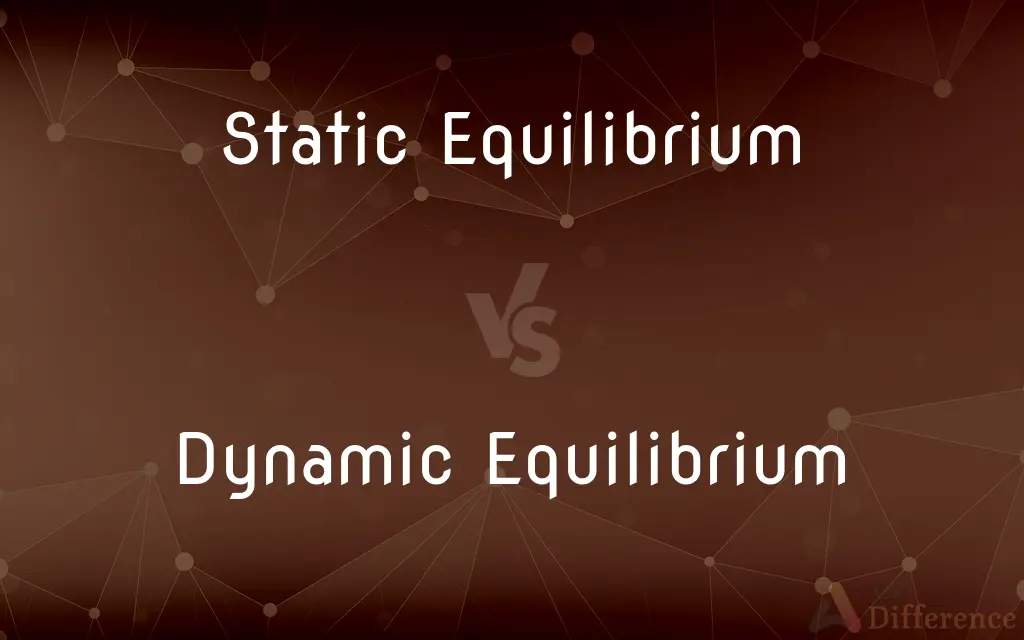Static Equilibrium vs. Dynamic Equilibrium — What's the Difference?
By Tayyaba Rehman — Published on December 11, 2023
"Static Equilibrium" refers to a system at rest with no motion, while "Dynamic Equilibrium" denotes a system in motion with opposing forces balanced, resulting in no net change.

Difference Between Static Equilibrium and Dynamic Equilibrium
Table of Contents
ADVERTISEMENT
Key Differences
Static Equilibrium is a state where all forces acting on an object are balanced, and the object remains at rest without any motion. In this condition, there's no net force acting on the object, so it remains stationary. Dynamic Equilibrium, on the other hand, is slightly more complex in nature.
In a Dynamic Equilibrium, there's continuous motion, but this motion is balanced. This means that even though there might be ongoing processes or changes within the system, the overall state of the system doesn't change. Opposing forces or reactions are occurring at the same rate, maintaining a steady state.
For example, consider a spinning top. In Static Equilibrium, the top would be stationary and not spinning. In Dynamic Equilibrium, the top is spinning, but it's perfectly balanced and not wobbling or falling over, despite the constant motion.
In the realm of chemistry, Static Equilibrium would suggest no reactions are taking place. Whereas in Dynamic Equilibrium, reactions are ongoing, but the rate of the forward reaction equals the rate of the reverse reaction, resulting in no net change in the concentrations of reactants and products.
To sum up, while Static Equilibrium represents a system at rest, Dynamic Equilibrium represents a system in motion, but both systems have a balance where there is no net change in the state or condition.
ADVERTISEMENT
Comparison Chart
Motion
No motion, at rest
Continuous motion
Net Change
None
None, despite ongoing processes
Examples
A book on a table
A spinning top
Chemical Context
No reactions
Forward and reverse reactions balanced
Balance
Forces balanced
Rates or processes balanced
Compare with Definitions
Static Equilibrium
A condition where an object remains stationary due to balanced internal and external forces.
The bridge stands firm in Static Equilibrium because of its architectural design.
Dynamic Equilibrium
A condition in which forward and reverse processes take place at equal rates.
In a closed container, the rate of evaporation and condensation of water reaches Dynamic Equilibrium.
Static Equilibrium
The point at which there's no tendency for motion.
Even when loaded with weights, the balanced scale shows Static Equilibrium.
Dynamic Equilibrium
An unchanging macroscopic state, despite ongoing microscopic processes.
Although reactions continue, the concentrations in the chemical system represent Dynamic Equilibrium.
Static Equilibrium
A situation where net external forces and torques acting on an object are zero.
The ladder resting against the wall without slipping or rotating demonstrates Static Equilibrium.
Dynamic Equilibrium
A continuously changing system that maintains an overall steady state.
In a saturated solution, the dissolving and crystallizing rates achieve Dynamic Equilibrium.
Static Equilibrium
An unchanging state of rest due to equal opposing forces.
The unmoving pendulum is an example of Static Equilibrium.
Dynamic Equilibrium
A balance achieved within a system in constant motion.
Despite constant cellular processes, the body's internal environment maintains Dynamic Equilibrium.
Static Equilibrium
A state where all forces on an object are balanced, resulting in no motion.
The book on the table is in Static Equilibrium because it isn't moving.
Dynamic Equilibrium
A state where opposing forces or reactions occur at the same rate, resulting in no net change.
The spinning top, perfectly upright, illustrates Dynamic Equilibrium.
Common Curiosities
What denotes a system at rest with no motion?
A system at rest with no motion is in Static Equilibrium.
Is a stationary book on a desk an example of Static Equilibrium?
Yes, a stationary book on a desk exemplifies Static Equilibrium.
Which equilibrium involves reactions with equal forward and reverse rates?
Dynamic Equilibrium involves reactions where the forward and reverse rates are equal.
Can a spinning object be in equilibrium?
Yes, if it's balanced and not wobbling, it's in Dynamic Equilibrium.
Can a system in Dynamic Equilibrium show constant motion but no net change?
Yes, in Dynamic Equilibrium, a system has constant motion but exhibits no net change.
Can systems in Dynamic Equilibrium eventually reach Static Equilibrium?
Potentially, but it depends on external factors affecting the system.
Is a balanced seesaw an example of Static Equilibrium?
Yes, a balanced seesaw, with no motion, showcases Static Equilibrium.
In what context is Dynamic Equilibrium commonly seen in chemistry?
Dynamic Equilibrium is seen when forward and reverse reactions occur at the same rate, leading to unchanging concentrations.
Do processes cease in Dynamic Equilibrium?
No, processes continue in Dynamic Equilibrium, but they balance out, causing no net change.
What's the key difference between Static Equilibrium and Dynamic Equilibrium?
Static Equilibrium involves no motion, while Dynamic Equilibrium entails continuous motion without net change.
Can a pendulum ever achieve Dynamic Equilibrium?
No, a pendulum swings back and forth due to forces acting on it but eventually reaches Static Equilibrium when it stops.
Which equilibrium represents a system with no net change despite ongoing processes?
Dynamic Equilibrium represents such a system.
Is a system with balanced forces always stationary?
No, if it's in Static Equilibrium, it's stationary; if in Dynamic Equilibrium, it has balanced motion.
Does Static Equilibrium only refer to objects?
No, Static Equilibrium can also refer to systems, like a market in economic equilibrium.
In what state is a system that's always changing but remains consistent overall?
Such a system is in Dynamic Equilibrium.
Share Your Discovery

Previous Comparison
Cumulative Preferred Stocks vs. Non-cumulative Preferred Stocks
Next Comparison
Leopard vs. Snow LeopardAuthor Spotlight
Written by
Tayyaba RehmanTayyaba Rehman is a distinguished writer, currently serving as a primary contributor to askdifference.com. As a researcher in semantics and etymology, Tayyaba's passion for the complexity of languages and their distinctions has found a perfect home on the platform. Tayyaba delves into the intricacies of language, distinguishing between commonly confused words and phrases, thereby providing clarity for readers worldwide.
















































